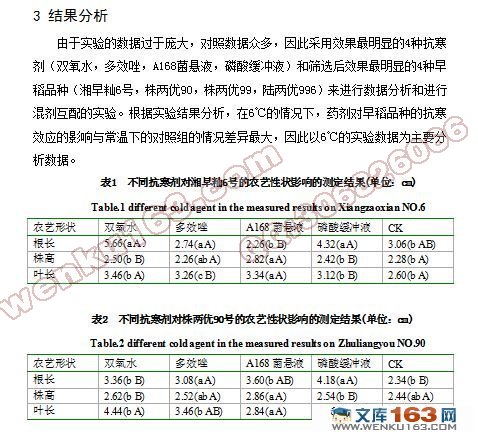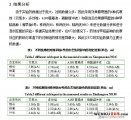长江中下游地区早稻抗寒剂的筛选及初步研究
来源:wenku163.com 资料编号:WK1636539 资料等级:★★★★★ %E8%B5%84%E6%96%99%E7%BC%96%E5%8F%B7%EF%BC%9AWK1636539
资料介绍
长江中下游地区早稻抗寒剂的筛选及初步研究(8100字)
摘 要:为了减轻长江中下游地区寒潮对水稻秧苗的危害,本实验以4种药剂及其互配而成的药剂进行了水稻抗寒筛选,并比较了其作用后早稻品种的农艺性状。结果表明: 1.5mmol/L双氧水和pH=7磷酸缓冲液都具有较好的效果,其农艺性状皆高于对照,A168菌悬液和多效唑的效果不明显,农艺性状与对照不均衡;在互配的混剂实验筛选中,与pH=7的磷酸缓冲液互配后的药剂抗寒效果提升效果都较好,农艺性状大多数皆高于对照。总体来说,单剂效果优与混剂。
关键词:寒害;早稻;抗寒剂;防治措施
Screening and preliminary of cold resistant agent for early season rice in middle and lower rechees of Yangtze
Abstract:In order to reduce cold damage on rice seedings in middle and lower rechees of Yangtze.In this experiment ,made of rice cold tolerance screening of four kinds of agent and their interaction with the agent,and compared the effect of agrionomic traits after the early rice varieties. The result shows that: PH=7 Phosphate buffer and 1.5mmol/L Hydrogen peroxide has the most obvious effect,the agronomic traits were higher than in control;bacterial suspension and MET were not obvious,the agronomic traits were uneven;in each experiment with mixture of screening, mixed each other pharmanceutical with PH=7 Phosphate buffer has the most obvious effect than others.Overall.single dosein better than mixture.
Key words:Chilling injury;early rice;cold agent;control measuies

目 录
摘要……………………………………………………………………………1
关键词…………………………………………………………………………1
1 前言…………………………………………………………………………2
1.1 水稻寒害的义……………………………………………………………2
1.2 分布、类型与危害………………………………………………………2
1.2.1 分布……………………………………………………………………2
1.2.2 类型……………………………………………………………………2
1.2.3 危害……………………………………………………………………2
1.3 影响寒害因素……………………………………………………………3
1.3.1 气象因素………………………………………………………………3
1.3.2 品种抗性………………………………………………………………3
1.4 传统防治…………………………………………………………………3
1.5 抗寒剂防治………………………………………………………………3
1.5.1 植物抗寒理……………………………………………………………4
1.5.2 抗寒剂研究现状………………………………………………………4
1.5 实验目的和意义…………………………………………………………5
2 材料与方法…………………………………………………………………5
2.1 实验药剂及早稻平品种…………………………………………………5
2.2 实验器材…………………………………………………………………5
2.3 药剂配置…………………………………………………………………5
2.4 实验方法…………………………………………………………………5
2.5 数据分析…………………………………………………………………6
3 结果分析……………………………………………………………………6
4 结论与讨论…………………………………………………………………9
参考文献 ……………………………………………………………………10
致谢……………………………………………………………………………12
|



